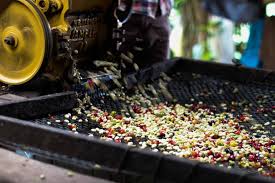Recent Post

Coffee processing - An overview about the different methods and their impact on flavor
Steffen Sauer
Jan 31, 2021
Purpose of the various processing techniques is to remove the coffee bean from the coffee fruit. Therefore, please remember the coffee cherry anatomy mentioned above. We must go into the details of those process differences as they affect the flavor of the coffee.
In this blog I will introduce you to the Natural Process, the Washed Process and the Honey Process. Afterwards I will summarize and explain the impact on the flavor.
The Natural Process
The Natural process is the oldest processing method, also known as dry process, unwashed, or natural sundried. They all refer to the same method of processing that originated in places without reliable access to water and usually involves drying coffee cherries in the sun. This process can take 3-6 weeks and usually works best in areas with low humidity and infrequent rain. This method allows the sweet and fruity flavors within the cherry flesh to be absorbed by the coffee bean.
The cherries are dried in the full sun on a concrete patio for several days until the pulp gets brittle and can easily fall off the beans. Then, the beans are dried again, without the pulp, until they reach the adequate moisture level. During all the time, the cherries are raked and turned several times a day to ensure even drying and to prevent them from spoiling. They get covered at night or during rain. After the cherries have been dried to the optimum level, they are sent to mills to separate the seeds from the rest of the dried fruit, the next process is called “hulling.”
Coffee processing using the dry method results in a characteristic intense fruity flavor profile with winey or berry notes. It gives a full body and sweetness combined with lower acidity than in the case of wet-processed coffees.
The Washed Process
The second process is the washed or wet process. In this method, the cherries are removed from the seeds before the drying process. To do this, the cherries are first sorted to ensure consistent ripeness levels, and then are run through de-pulping machines that squeeze the cherries until the seeds pop out. Then the seeds and skins are separated, and the seeds move into tanks filled with fresh water for around 14-24 hours to allow the natural enzymes and bacteria begin to break down the remaining mucilage before they either follow a ferment-and-wash process or a machine-assisted wet process to remove the rest of the mucilage before they are dried.
In a ferment-and-wash process, the remaining mucilage is broken down by microbes and yeast via fermentation and then is washed with water again to remove the mucilage from the seeds.
In a machine-assisted process, the cherries are mechanically scrubbed and most of the mucilage of the seen is removed through friction.
After the seeds are washed, they are dried in the sun on patios or on raised beds, until a suitable moisture content within the limits of 11-14% is reached. After around two weeks, the beans are ready for the final stage of the polishing process where any remaining silver skin will be removed.
Even though it is a demanding and expensive process since it requires a mill to be built on the farm or else the beans need to be transported to an existing mill where the entire processing can take place, it allows for more control and modification of a sensory profile. “Washed” coffees usually have gentler, more noble sensory profile, and more intense citrus fruit acidity than those dry-processed.
Honey Process
Honey process, also known as Pulped Natural, begins in the same way as the washed process, except that after sorting, the beans are left with the mucilage still on them. . The beans are then stuck together and look like covered in honey – this is how the process got its name. The amount of pulp remaining on the bean will determine whether it is black, red or yellow honey process and will determine the flavor profile and characteristics of the coffee.
The result combines the best cup results from both the natural and wet processing methods - coffees with high sweetness, a very fruity profile and delicate sweet acidity. It is also more repeatable than the dry process and gives a fuller body than the wet process.
Each processing method has advantages and disadvantages, and typically the option chosen by the farmer is dictated by the climate in which the coffee is grown.
For example, it would be extremely difficult for farmers in high humidity countries to process their coffee using the honey process without risk of an undesirable level of fermentation occurring. Equally in countries where the temperature is cooler or prone to frequent rainfall, utilizing the dry process significantly increases the risk of mould forming.
By combining coffees from different growing regions and processing methods into a blend, roasters can balance cup profiles together to give a sense of body as well as balance the acidity and sweetness.
Coffee processing methods and their impact on flavor
Of course there are several influential factors when it comes to the flavor of coffee – the growing conditions such as soil, climate, elevation, plants surrounding the coffee plants, the coffee species, the variety, the farming practices, the picking and processing methods, shipping, storing and of course the roasting.
Closing the coffee processing topic please see the summary below:
Natural Process:
- Countries with little water and hot climate
- Generally, more fruity and fuller-bodied.
- Berries, wine tannins, currants
Washed Process:
- Countries with good water supply
- Flavors more inherent to the bean itself, rather than the pulp and skin.
- Citrus acidity (lime, lemon, orange peel, green apple)
Honey Process
- Countries with water supplies and hot climate (Brazil)
- Sweetness, caramel, toffee, molasses, sugar cane
Coffee from the same plantation, the same harvest and identical variety can taste completely different based on the coffee processing!
← Older Post Newer Post →



